
|   |

|   |
'Nrityaarohini Festival' celebrated the birth centenary of Rohini Bhate - Manjari Sinha e-mail: manjari@sinha.com Photos courtesy: Aarohini July 14, 2024 Guru Rohini Bhate was a versatile Kathak exponent, choreographer, lyricist, composer, writer, translator, theoretician, and thinker. Her birth centenary year (14th of November 2023 to 14th of November 2024) is being celebrated as 'Rohini Dyuti', the yearlong series of performances, seminars, film screenings, discussions et al, across the country. 'Rohini Dyuti', the glow of Rohini's multifaceted personality and the aura of her versatility, was conceived and initiated by Neelima Adhye, one of her senior most disciples last November on Rohini Bhate's 100th birthday with a two-day dance festival, where some of her special dance creations were presented by the Nritya Bharati repertory, along with a multi-disciplinary seminar. Continuing the 'Rohini Dyuti' series, the 'Nrityaarohini Festival', Pune (28th - 29th of June, 2024) was organised by Prajakta Raj and her Aarohini Art Welfare Organisation in association with Nritya Bharati, the Kathak dance academy established by Guru Rohini Bhate way back in the year 1946, continuing under the guidance of Neelima Adhye after her passing away. One could feel the palpable presence of Rohini throughout the Nrityaarohini Festival, especially with her short video clips interspersed in-between the performances and with the screening of 'Time & Space', the beautiful film focused on her and her art. The two-day festival opened with Kathak performances by Prajakta Raj and her disciples learning at Aarohini. The second evening featured Guru Rohini Bhate's senior disciples, like Roshan Datye, Neelima Adhye, Amla Shekhar, Prerana Deshpande, Rajshree Jawadekar, Asawaree Patankar, Abha Wamburkar, Sharvari Jamenis, Rujuta Soman, Maneesha Abhay, Prajakta Raj and the disciples of Guru Roshan Datye like Abha Auti, Dhanashree Natu, and Ketaki Wadekar et al. Some of Guru Rohini Bhate's rare dance creations were also presented on both evenings. 'Time and Space', a documentary film by Carolin Dassel, a German disciple of Guru Rohini Bhate, was screened at the National Film Archives Institute, Pune, followed by a discussion with Neelima Adhye during the second session held on the 29th morning. Introducing Nrityaarohini Festival, Prajakta remembered her Guru and informed that through this festival she wanted to showcase the incredible work of Guru Rohini Bhate, her total dedication towards dance and her selected dance works. She said, "Rohiniji used to say, Parampara thrives with new additions to it by a Guru's disciples, hence we are also showcasing the dance works of her disciples including those who are propagating the Parampara on foreign soils like her German disciple Carolin Dassel teaching Kathak in Germany." Nrityaarohini opened with Omkar Vandana, "Pratham Naad Omkara", a Dhrupad written by Tansen, composed in raga Bhathiyar set to Chautala and presented by the disciples of Prajakta Raj. Taal Chautala continued for the technical aspect of Kathak with Chalan, Thaat, Aamad, Sangeet ka Tukda, Paran, Aamad et al. The youngest age group performed the Natyarambha mudras reciting Sanskrit shlokas describing the Asamyukta (one hand gesture) and Samyukta Hastas (both hand gestures) with their viniyoga, from Abhinaya Darpana. The subsequent age groups presented the musical Kavittas written and composed by Rohini - the Radha-Krishna ched chhad and the Vrindavan Raas, the Kaliya Daman and Govardhan Leela Kavittas to name a few. There was a rich musical composition 'Raag Sagar', a garland of nine ragas with a 'Samadhun' geet that went "Baran baran ke phool phule" describing the nayika's yearning for her beloved where ragas like Basant, Bahar, Kedar, Adana, Malkauns and Lalit etc changed according to words of the song (written by Rohini) describing the multihued bhavas. Performances presented in the first half of the inaugural evening ended with Trivat, a unique blend of percussion mnemonics and musical notes with nritta, the technical aspect of Kathak. 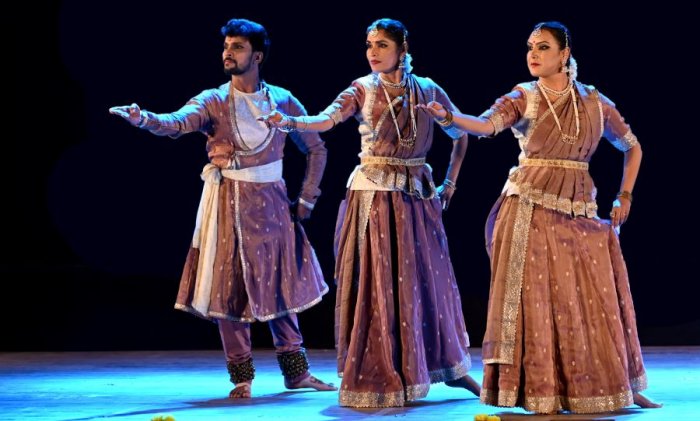 Triveni In the second half of the inaugural evening, they opened with Raatri Sukta, a hymn in an ode to the goddess night from the Atharva Veda. The group of female dancers clad in white dhoti and uttariya looking like Ashram Vasins and the melodious Aalap on flute in raga Jhinjhoti, the night raga created the perfect aura for the mythical piece which reminded us of Rohini Bhate's 'Ushas Sukta' from Rig Veda. Taal Triveni composed by Rohini was a rare taal of 33 beats time cycle combining teentala of 16 beats, Jhaptaal of 10 beats and Rupak of 7 beats, danced by Prajakta Raj, Venu Riswadkar and Mayur Shitole. The difficult taal was first recited and played on tabla and pakhawaj along with the lahera, the musical refrain marking the 33 beats in one go. The discerning audience of Pune enjoyed even this melodious musical preface with their applause before the three chiselled dancers entered the stage with an electrifying Uthaan. The Thaat, Aamad were followed with the Ganesh Paran composed by Rohini in Triveni taal. The in-sync padhant by Asawari Patankar was also remarkable. There was Paran-Jodi Aamad "Dhatak thunga", Sangeet ka Tukda, to Ginti Ki Tihais all in the time cycle of the 33 beats of Triveni taal climaxing in the Tatkar and the Gopuchch Tihai. 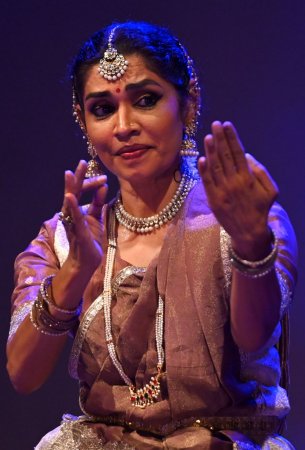 Nanadi by Prajakta Raj 'Nanadi' came as a Baithaki Bhava Thumri next (announced wrongly as 'Baitha Bhaav), presented by Prajakta Raj in a sitting position. Emoting the challenging bhavas of a Vartaman Gupta nayika on the Pada "Sarup nirupah dose nanadi"; where a married nayika returning from her illicit rendezvous, makes up a variety of excuses and undue explanations to her Nanadi, i.e. sister-in-law. This Bandishi Thumri in raga Desh was set to Chanchar Theka of Deepchandi. Though the opening Doha "Brindavan dhaam niko, Yamuna ke neer niko…" which describes Radha-Krishna's divine love, was not quite appropriate in this scenario, Prajakta did full justice to the Parakiya kind of nayika, especially with the hilarious bribing of her young Nanadi with her bangles and other jewellery towards the end. 'Baal Bhakta' was a group presentation by Prajakta's young students from Aarohini. The song was in Marathi Keertan style, describing the intense devotion of child devotees of Vishnu like Dhruva, Bhakta Prahlad and young Dhyaneshwar, with vignettes of tableau, composed by Chaitanya Kunthe. This was followed by a short video of Rohini Bhate's 'Sampoorna Ramayan' in solo abhinaya. Marathi Abhang in praise of Vitthala took the inaugural evening to its climax where all the performing groups gradually joined the accentuating tempo of 'Vitthala Vitthala.' The audience also joined with their claps keeping up the beats of the Abhanga that ended with a standing ovation. The morning session on the 29th was held at the National Film Archives Institute, Pune, with the screening of 'Time and Space', an intriguing film by Carolin Dassel. Her sensitive perception of the Art and the journey of Guru Rohini Bhate, captured through her camera, was followed by an informal conversation with Neelima Adhye about the film and Guru Rohini Bhate. Unlike the modern day tech savvy films, this was an unedited version of Carolin's experiences as a foreign student who came to study under Guru Rohini Bhate and learnt not just dance but also a lot about Indian culture by just living with and observing her day-to-day life. Neelima said Carolin would come with her camera and keep taking short videos of whatever she saw in the class or outside, even while travelling with her Guru and her troupe. 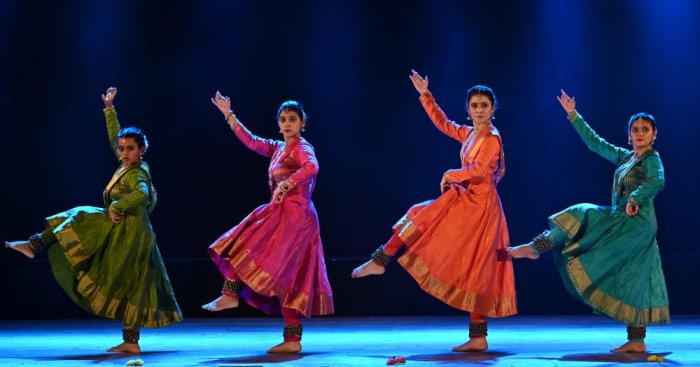 Rangaraj The third and concluding session featured Rohini Bhate's senior disciples performing her rare compositions, opening with 'Rangaraj'. This was an invocation to Ganesha, the elephant headed God, from the era of the Peshwa rulers in Maharashtra, performed by the students of Neelima Adhye at Nritya Bharati. Rhythmically composed in raga Jhinjhoti "Rang Raj aaj Maharaj Ganapate" was sung and performed in Thaah, Dugun, and Tigun with the changing stress on beats according to the changing tempo. Next came Sohan taal performed by Abha Wamburkar and her students from Deeksha, her dance institute. This unique taal of eleven and a half beats time cycle was created by Rohini in memory of her Guru Pt. Sohan Lal, after he left for Chennai. The choreography highlighted the fractional beauty of the challenging Ganesh taal with Ganesh Paran, Tode Tukde and Parmelu all following the fractional division of Sohan taal like a Chhand in tisra and misra jati. 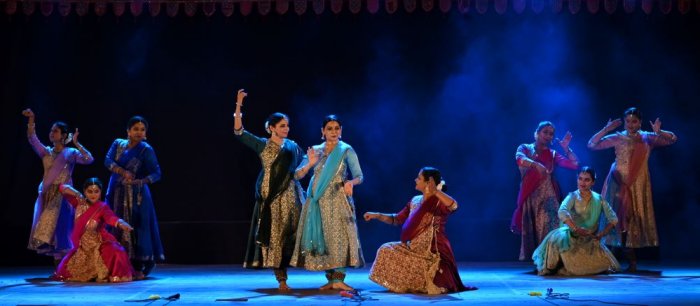 Taal Ganesh The duet by Neelima Adhye and Asawari Patankar next was based on the poetry of the medieval poet Giridhar, "Daheki daheki ghan uthat chahun ore" depicting the folklore of monsoon season where two damsels are both going through the pangs of separation from their beloveds. The dance conception used the same words interpreted differently by the two dancers, which reminded us of Rohini Bhate's fertile imagination even in the selection of sahitya for her abhinaya Padas. "Jasoda ke Mandir" by Rajshri Javadekar and her students was a delightful dance celebrating Krishna Janma, "Aaj Nand ke dware bheer", a Pada by Surdas before the students of Roshan Datye presented 'Chaturang', a composition comprising four elements - Sahitya, Sargam, Tarana and Natawari bols composed in four ragas and four talas respectively. The Chaturang composition "Gavat naachat chalat chaar sakhi" was written by Rohini Bhate opening with raga Patdeep. The Sargam part was in raga Jhinjhoti set to drut ektala, the Natwari bols were composed in raga Chandrakauns and Matta taal of nine matras and Tarana in raga Kalawati teentaal, with the sahitya "Murali man haryo ki ghar aangan na suhaaye" recited as a Doha, before the Tarana. 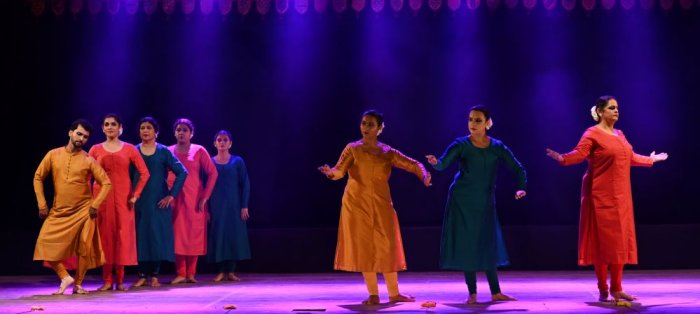 Time 'Time' conceived by Rohini, was presented next as an abstract item inspired by the poem. "Time as order, Time as flow Time flies, Time freezes Time inspires, Time teases!" It was a sequence of expressions about the perception of Time conceived and choreographed by Rohini Bhate with its unusual original recorded music. It felt as if Time was/is also the eternal witness to the countless creations Rohini has left to be cherished forever. 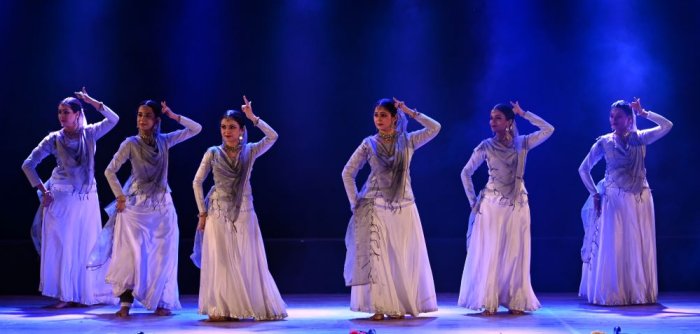 Bhole Shiv Prerana Deshpande and her students presented "Bhole Shiv", a composition in raga Ahir Bhairav set to Rupak taal of 7 beats time cycle. Sharvari Jamenis, Rujuta Soman, Manisha Abhay and their students presented Ganesh taal created by Rohini, where the 21 beats of the time cycle were divided in two halves of ten and a half matras. The group performed Ganesh Paran, Kavitta, Parmelu, Ladi etc in this difficult taal. 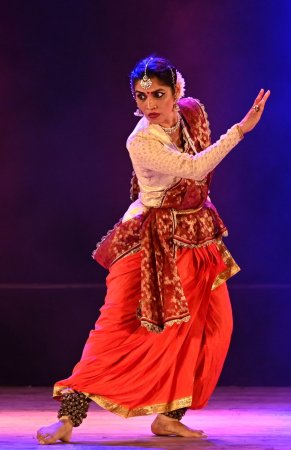 Prahlad Katha Prajakta Raj presented a 'Lamchhad' (very long) Kavitta based on the mythological story of Prahlad with dramatic execution of killing the treacherous demon Hiranyakashipu, saving his son Prahlad, a great devotee of Vishnu, who takes Narasimha avatara as half man, half lion. Tridhara showcased the technical aspect, Padhant and Tatkar, an abstract depiction of space, time and naad. Doha couplets written by Rohini depicting different nayikas reached Nrityaarohini to its climax with Aarati in praise of Guru. It started with Guru Mohanrao Kallianpurkar's poem in praise of his Guru Bindadin Maharaj - "Bandaun Guru Binda ke charana" and gradually with all the participants and musicians joining them, culminated into "Bandaun Guru Rohini ke charana" heralding a standing ovation. 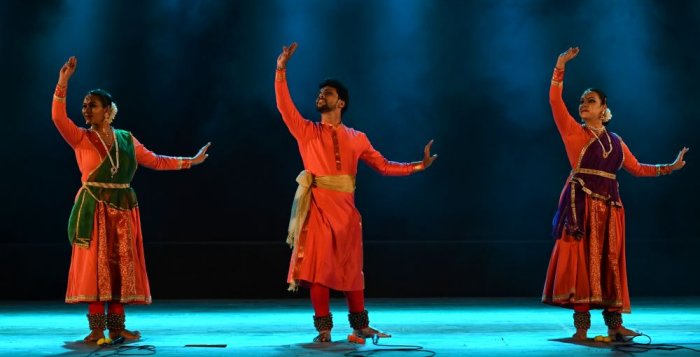 Tridhara Special mention and admiration goes to the gifted anchor Nrupa Soman and the competent musicians - Nikhil Pathak and Kartikswami Dahifale on tabla, Krushna Salunke on pakhawaj, Yashwant Thitte and Ameya Bichu on harmonium, Arpita Vaishampayan and Atharva Vairagkar on vocals, Dhaval Joshi on flute, and Asawari Patankar and Prajakta Raj on padhant. Watching the high standard of performances, and the huge number of Kathak dancers that participated in the two-day festival, it was hard to believe that till the 1940s there were hardly any classical dancers in Pune. Although classical music, Natya Sangeet, and Bhaav Geet to musical theatre (Sangeet Natak) had huge fan following, dance was a taboo in middle class music and theatre loving families, where any kind of dance practice was looked down upon. The herculean effort of Guru Rohini Bhate brought dance, especially Kathak to the limelight. Her training in classical Hindustani music and her innate erudition brought literary content and classical compositions, other than the regular Thumri, Dadra and Bhajans used for the abhinaya segments. She brought seasoned musicians like Dr. Prabha Atre, Pt. Suresh Talwalkar and Appa Saheb Jalgaonkar to accompany her dance. No wonder Nrityaarohini, the two-day festival of Kathak, offered sumptuous content and the best of accompanying musicians to enhance the qualitative presentations. 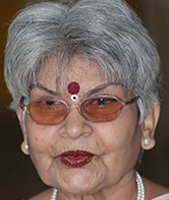 Manjari Sinha has an M.A. in Sanskrit and Music, and Sangeet Prabhakar in vocal, tabla, sitar and Kathak dance. She has regular columns in national dailies as a music and dance critic. |